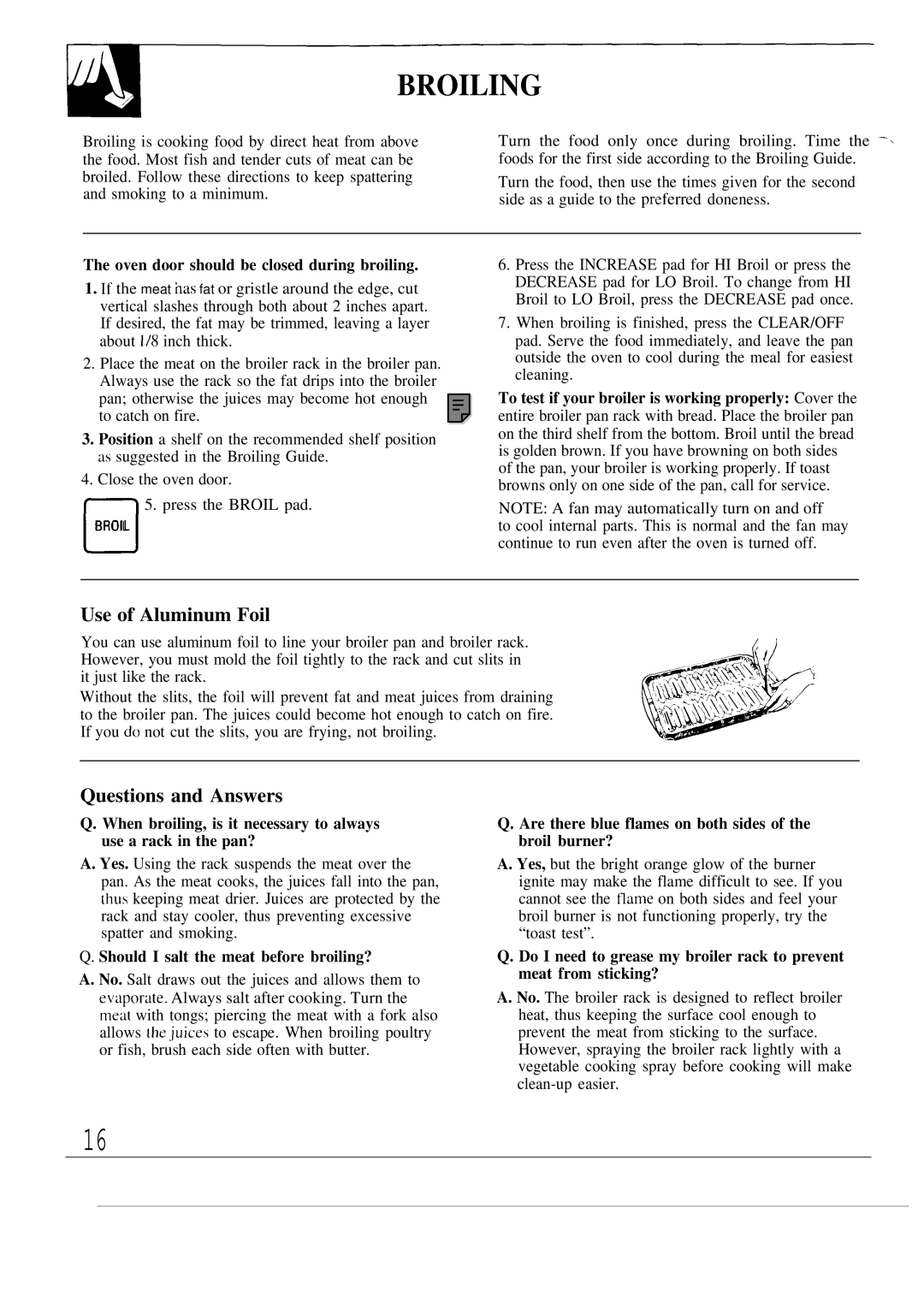
BROILING
Broiling is cooking food by direct heat from above the food. Most fish and tender cuts of meat can be broiled. Follow these directions to keep spattering and smoking to a minimum.
Turn the food only once during broiling. Time the ‘. foods for the first side according to the Broiling Guide.
Turn the food, then use the times given for the second side as a guide to the prefemed doneness.
The oven door should be closed during broiling.
1.If the meat has fat or gristle around the edge, cut vertical slashes through both about 2 inches apart. If desired, the fat may be trimmed, leaving a layer about 1/8 inch thick.
2.Place the meat on the broiler rack in the broiler pan. Always use the rack so the fat drips into the broiler pan; otherwise the juices may become hot enough to catch on fire.
3.Position a shelf on the recommended shelf position as suggested in the Broiling Guide.
4.Close the oven door.
6.Press the INCREASE pad for HI Broil or press the DECREASE pad for LO Broil. To change from HI Broil to LO Broil, press the DECREASE pad once.
7.When broiling is finished, press the CLEAR/OFF pad. Serve the food immediately, and leave the pan outside the oven to cool during the meal for easiest cleaning.
To test if your broiler is working properly: Cover the entire broiler pan rack with bread. Place the broiler pan on the third shelf from the bottom. Broil until the bread is golden brown. If you have browning on both sides of the pan, your broiler is working properly. If toast browns only on one side of the pan, call for service.
NOTE: A fan may automatically turn on and off
to cool internal parts. This is normal and the fan may continue to run even after the oven is turned off.
Use of Aluminum Foil
You can use aluminum foil to line your broiler pan and broiler rack. However, you must mold the foil tightly to the rack and cut slits in it just like the rack.
Without the slits, the foil will prevent fat and meat juices from draining to the broiler pan. The juices could become hot enough to catch on fire. If you do not cut the slits, you are frying, not broiling.
....
..l@$>:,{ ‘
()\~&l!!;&<q\> ‘
Q&
(9
Questions and Answers
Q. When broiling, is it necessary to always use a rack in the pan?
A. Yes. Using the rack suspends the meat over the pan. As the meat cooks, the juices fall into the pan, thus keeping meat drier. Juices are protected by the rack and stay cooler, thus preventing excessive spatter and smoking.
Q. Should I salt the meat before broiling?
A. No. Salt draws out the juices and allows them to evapor~te. Always salt after cooking. Turn the meti[ with tongs; piercing the meat with a fork also allows the <juices to escape. When broiling poultry or fish, brush each side often with butter.
Q. Are there blue flames on both sides of the broil burner?
A. Yes, but the bright orange glow of the burner ignite may make the flame difficult to see. If you cannot see the flame on both sides and feel your broil burner is not functioning properly, try the “toast test”.
Q. Do I need to grease my broiler rack to prevent meat from sticking?
A. No. The broiler rack is designed to reflect broiler heat, thus keeping the surface cool enough to prevent the meat from sticking to the surface. However, spraying the broiler rack lightly with a vegetable cooking spray before cooking will make
16
